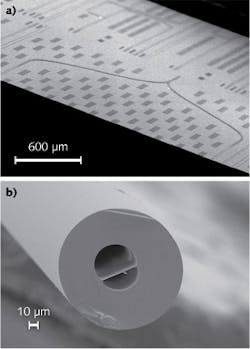Twenty years have passed since the invention of quantum-cascade lasers (QCLs) in 1994. Despite progress, mid-infrared (mid-IR) technology has not yet reached the same level of maturity as its near-IR counterpart due to the lack of efficient broadband detectors and the difficulty in fabricating fully integrated optoelectronic components in this wavelength range.
Mid-IR wavelengths have been used in optical communications, tunable laser spectroscopy, and most recently in microscopy—exhibiting substantial benefits in transmittance and sensitivity with respect to the broadly used light in the visible or near-IR range. As of February 2015, however, the conclusion of the European Union-funded research project CLARITY (Compact uLtrA-efficient mid-infRared photonIc sysTems; www.clarity-project.eu) has indeed brought some “CLARITY” to the mid-IR technology landscape by addressing many of its fundamental technological and engineering issues through the successful demonstration of mid-IR integrated components, optical fibers, low-noise quantum-cascade lasers (QCLs), and multiwavelength QCL arrays.1-4
SiGe mid-IR integrated platform
Continuously increasing interest in silicon photonics inspired the CLARITY consortium to investigate CMOS-compatible technologies for the mid-IR, aimed at the development of devices such as integrated multiplexers, couplers, splitters, and the investigation of nonlinear behavior.
Nonlinear activities focused on mid-IR to near-IR wavelength conversion by investigating a silicon-germanium (SiGe) platform due to its inherent advantage in achieving efficient coupling with QCLs and its flexibility in dispersion engineering. In the context of CLARITY, a wide range of devices were designed by National and Kapodistrian University of Athens (Athens, Greece) and CEA-LETI (Grenoble, France), fabricated by CEA-LETI, and characterized by the University of Southampton (Southampton, England) and Technical University Darmstadt (TUD; Darmstadt, Germany), demonstrating mid- to near-IR wavelength conversion, broadband supercontinuum generation, and the successful fabrication of multifunctional CMOS-compatible chips that form the basis for smart lab-on-a-chip systems (see figure).
Highly nonlinear mid-IR telluride fibers
Tellurite glass is a highly nonlinear, highly transparent mid-IR glass material; however, it has an absorption peak for the hydroxide (OH) fundamental vibration between 3 and 4 μm. Reducing the OH impurity level is critical when considering the use of tellurite glass optical fibers for nonlinear applications in the 2–5 μm wavelength region. Within the CLARITY project, the Optoelectronics Research Centre at the University of Southampton demonstrated a reduction in the OH-induced loss at 3.4 μm down to 10 dB/m in an optical fiber. Within the CLARITY project, small-core fiber samples were fabricated and proved their potential for nonlinear applications above 2 μm.
Low-noise QCLs
Low-intensity noise performance of mid-IR QCLs is indispensable for many sensing applications. CLARITY members National and Kapodistrian University of Athens and TUD pursued two strategies to achieve this result. Injection locking was demonstrated below and near the threshold of a free-running slave laser, resulting in efficient low-noise operation. A direct-absorption experiment of carbon monoxide at 2193 cm-1 using a reduced-intensity-noise distributed-feedback QCL at TUD saw a 30% lower detection limit in comparison to the free-running case.
Multi-wavelength QCL arrays
In collaboration with CEA-LETI, III-V Lab (Palaiseau, France) designed and fabricated a monolithic integrated multiwavelength source consisting of 15 lasers emitting from 2220 to 2320 cm-1 that was integrated onto a SiGe wavelength multiplexer. The large tunability allows the detection of several molecules with narrow absorption features (like carbon monoxide and carbon dioxide) or one complex molecule with a broad absorption profile (such as heavier carbohydrates). In addition, Norsk Elektro Optikk (Skedsmokorset, Norway) has designed a new laser driver with excellent noise properties that is able to drive single QCLs and QCL arrays.
According to professor Dimitris Syvridis, coordinator of the project, the technologies developed within CLARITY pave the way for the photonic integration in the mid-IR regime, combining all critical building blocks (tunable lasers, sensing elements, and receiver) on the same platform.
REFERENCES
1. C. Juretza et al., IEEE J. Quantum Electron., 51, 1, 1–8 (Jan. 2015).
2. F. Michel et al., Opt. Lett., 39, 21, 6351–6354 (2014).
3. K. Hammani et al., Opt. Express, 22, 8, 9667–9674 (2014).
4. M. Brun et al., Opt. Express, 22, 1, 508–518 (2014).

